In my post of a couple of days ago entitled It’s Fall And They’re Fallin’, I showed how an amateur (myself) goes about collecting fallen black walnuts from his lawn. Today I will introduce you to a friend of ours, Jasper, whom you may recall from a previous post entitled Bee Hunting In The Ozarks, is an experienced bee keeper, as well as the regions most skilled practitioner of the vanishing art of “coursing” bees.
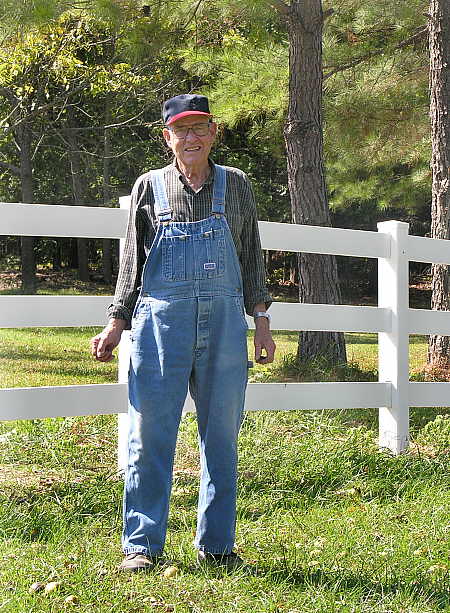 Â
Â
 I would say without hesitation that Jasper (Jay) is an old pro at gathering black walnuts. He is consistently this area’s top seller to Hammons Nut Products, who purchase black walnuts from local gatherers in 12-16 states each fall. Jasper begins his nut gathering each year just prior to the opening of the Hammons collection stations, which, this year, will occur tomorrow.
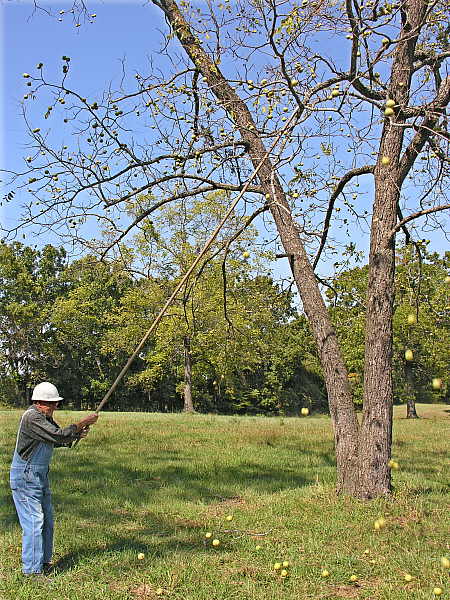 Â
Â
The first step in the gathering process for this seasoned harvester is to shake the lower limbs of the trees, so that the loose nuts that remain attached to these limbs will fall to the ground. The pole that Jay is using has a hook at the end, which Jay drapes over a limb and then tugs a few times. As you can see from the photograph above, Jay wears a hard-hat while performing this task. If you have even been hit in the head by a large, unhulled walnut that has fallen from the top of the tree, you will immediately understand the precaution that Jasper takes – it hurts!
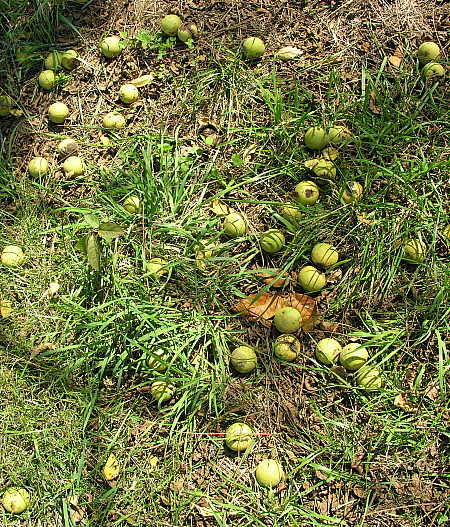 Â
Â
The photograph above shows the effectiveness of shaking the limbs. Now, one only has to pick up the nuts and load them into the truck.  On Jay’s next visit to pick up nuts, he will bring an extension for his pole, which will allow it to reach limbs 20 feet higher than the lower limbs of today’s harvest.Â
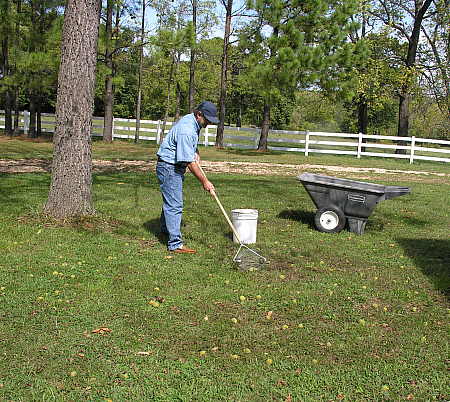
In last Friday’s post, you may remember this photograph, which shows me using an interesting tool designed to make the nut gathering process easier to accomplish. I love this tool. Two years ago, I showed it to Jasper and asked if he would like to try it out. “Sure would,” he replied. About an hour later, when I looked across a pasture to see how Jay was coming along, I noticed that he wasn’t using the tool I had lent him. When I inquired later as to why he had abandoned the tool, looked at me and replied “It just slows me down.”
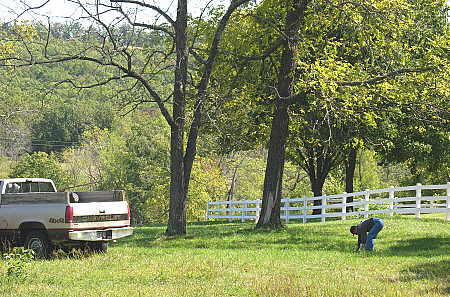
And this is how Jasper prefers to gather the fallen walnuts – by hand, the old-fashioned way.  But that is how the pros do it. Keep this photograph in mind as I take this opportunity to become a little bit analytical.
The record that the title of this post refers to is the personal annual total amount of nuts gathered by Jasper, which stands at over 17,000 pounds of hulled black walnuts, a record he achieved 2 years ago. Jasper thinks he may top that amount this year, based upon the trees he has examined to date. Now for some simple math. Recall from It’s Fall And They’re Fallin’, that we derived the average weight of a small sample of black walnuts that I gathered the other day:  .0712 pounds/nut, or about 14 nuts per pound.
Jasper tells me, based upon his experiments, that a hulled walnut weighs about 60% less than it’s unhulled weight. I have not confirmed this, but taking him at his word, we can derive the following. To end up with 17,000 pounds of hulled walnuts, one has to start with 28,333 pounds of unhulled nuts (17,000#/.60). If we take my calculation of 14 unhulled nuts per pound as accurate, then Jasper would have had to pick up a total of 396,666 nuts to arrive at 17,000 pounds of hulled walnuts.
When Jasper achieved this personal record two years ago, Hammons was paying $10.00/cwt for hulled walnuts. So Jasper’s gross revenue from his efforts was $1700. Considering the fuel expense involved in multiple trips to the collection station (about 25 miles distant), as well as multiple trips to many area farms, the net revenue does not amount to all that much income – especially when one imagines the amount of labor involved in hand gathering nearly 400,000 nuts!
By the way, Jasper will celebrate his 83rd birthday in two weeks. Happy birthday, Jay, and we wish you many more to come!



Amazing.
I wonder how many hours that took…
I saw a vehicle used to ram the trunk of walnut trees in order to shake the nuts down. It looks like a tank, and that’s not only to have the force to shake the tree but to protect the driver from the result of it.
Pablo – I have seen a hydraulically operated tree shaker implement that attaches to the three-point hitch of a tractor, which is used for harvesting nuts and fruit. They don’t seem to be in use for walnut harvests, maybe because there aren’t large concentrations of black walnut trees in any one location. Now, perhaps when your pecan plantation comes of age…….
Duane – I don’t know how many hours Jay spent collecting the 17,000 pounds of nuts, but it was certainly many more hours than I would have had the stamina for!
Hal, you mean you are not going to go for the record. hehe
Having worked in the bee business for many years, I know what “royal jelly” is and other odd beekeeping terms but I have never heard of “coursing.” Can you fill me in on that one?
Ed – “Coursing” bees is the term used down here for tracking bees back to the tree in which they have made their hive. It is an activity that was once common among the subsistance farmers who lived in the area, but is becoming less common as time passes. The following link will take you to a short photo essay I created on the subject:
http://www.mitzenmacher.net/photogallery/v/TheBeeHunt/
Sam – I have a hard enough time just keeping the lawn clear of walnuts prior to Jasper’s arrival here each fall. I don’t know what his secret is, but I couldn’t even hope to keep up with him. In fact, should I be fortunate enough to live to his age, I will be content to have 1/4 the energy that he possesses!
Considering I can hardly even bend over at this point, let alone walk, Jasper’s efforts are even more mind-boggling than they might have been last year! I hope he breaks his record – you will keep us up to date, won’t you?
Mrs. S – I’ll let you know how Jasper did this year as soon as the collection stations close. You’ll keep us up to date on your progress as well, won’t you?
These posts are always a pleasure to read.
I’ve seen a Moderm Marvels program (a very enjoyable series on the Discovery Channel) entitled “Harvesting”. In that episide, large-scale walnut operations employ tree shakers; a large machine that grabs hold of the trunk about 5-6 feet up, and vibrates the nuts off the tree in a couple of seconds. Another machine comes by and scoops them up in one shot. The trees have a minimum row seperation for the equipment to pass. Simply amazing.
MrC – I’ve seen a number of Modern Marvels episodes, but I missed the one you mentioned. I’ll keep an eye out for it – thanks.
I imagine one would have to have access to a great number of trees to justify what must be a huge capital expense. Maybe I’ll ask Jay if he’s interested 😉
BTW – The Discovery Channel is one of our favorites, and we’re about to get Discovery HD. I’m almost as excited about our first HD set as I was about my first computer (a Digital Equipment Corporation Rainbow 100).
Thanks for the link on bee coursing. We used to get calls all the time from people who found a swarm of bees. Most of the time when they were in a tree hollow, there was nothing to be done. But if they were swarmed on the outside of the tree in reach of a pole much like what Jasper used to shake walnuts down, we would be able to provide them with new ‘housing’ and capture them with a fairly high success rate. I would say that in the ten years we raised bees, we captured on average a half dozen swarms per year. The year after the business was sold, trachea mites infested our part of the country and killed off around 75% of all bees.
Ed – This area was also affected by the mites, but is making a slow and steady recovery.
I am happy to have bees take up residence on our property, so we just leave them “bee” where we find them. To help Jasper out however, we let him take one hive two years ago. After coursing the bees to find the old dead oak, he cut it down, smoked the bees out, and removed the honeycombs from the tree. The honeycombs were put into frames in Jasper’s bee enclosures, and the bees voluntarily followed suit.
Wow, what great guy. Imagine how many times he bends over… probably has abs of steel even at 83.
Thanks for sharing with us!
And happy birthday to Mr. Jasper.
Yes, I’ll keep you up to date – as soon as I go into labour, I’ll post it on my blog. Catch is, you’ve got to visit 😉
Hal, I miss my HDTV! You’re going to love it, especially Discovery HD.
I cancelled my subscription to satellite as they couln’t get line of site to all the satellites for me to get local and HD coverage.
FC – Jay is pretty amazing, and it is quite interesting to sit in conversation with him.
Mrs. S – Will do!
Duane – I’m anxiously awaiting for all the pieces to come together – maybe another week or so, and I’ll be up and running. I’ve discovered that until you actually start trying to integrate all the components of a home theater system, it’s hard to imagine all of the details of interconnection, native resolutions, upscaling, downscaling, HDMI, PCI, coax digital audio, optical digital audio, etc., etc. It’s been a learning experience.
Pingback: Ranch Ramblins » Blog Archive » No Hay Today